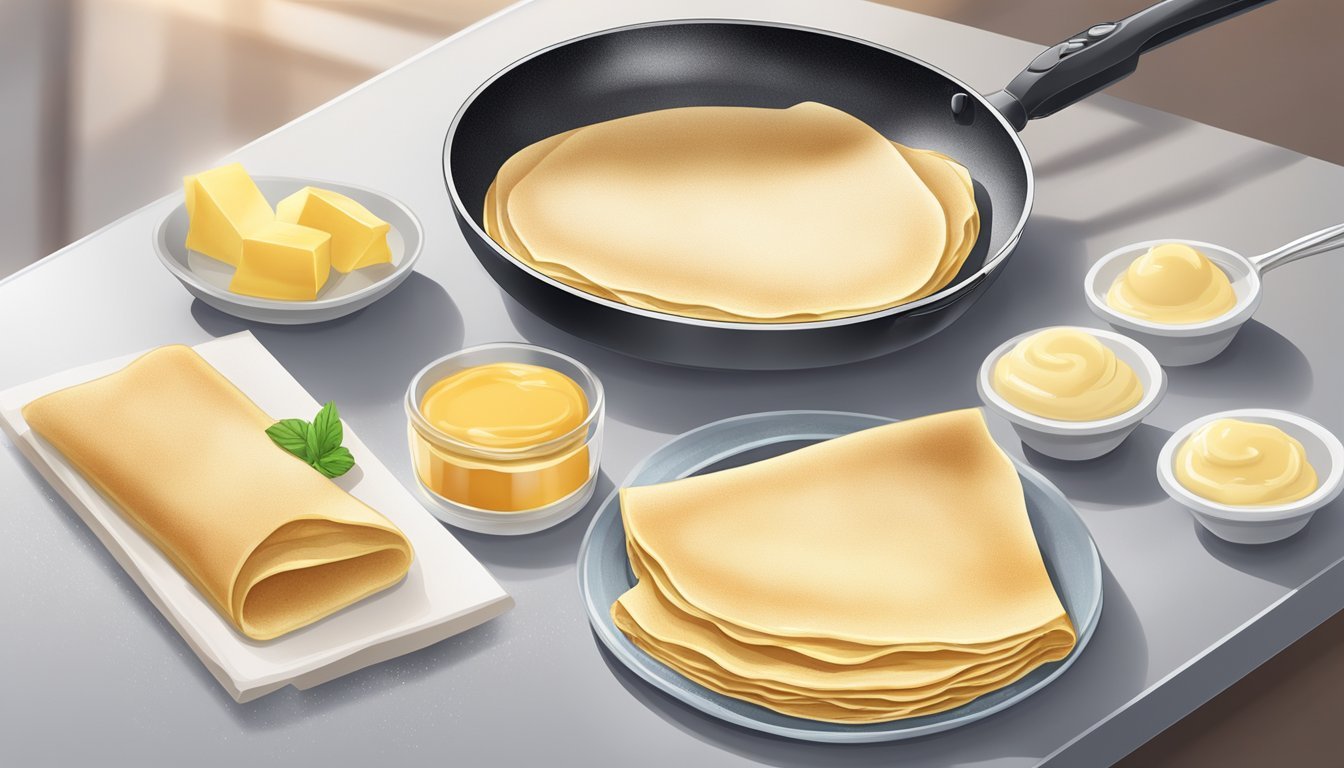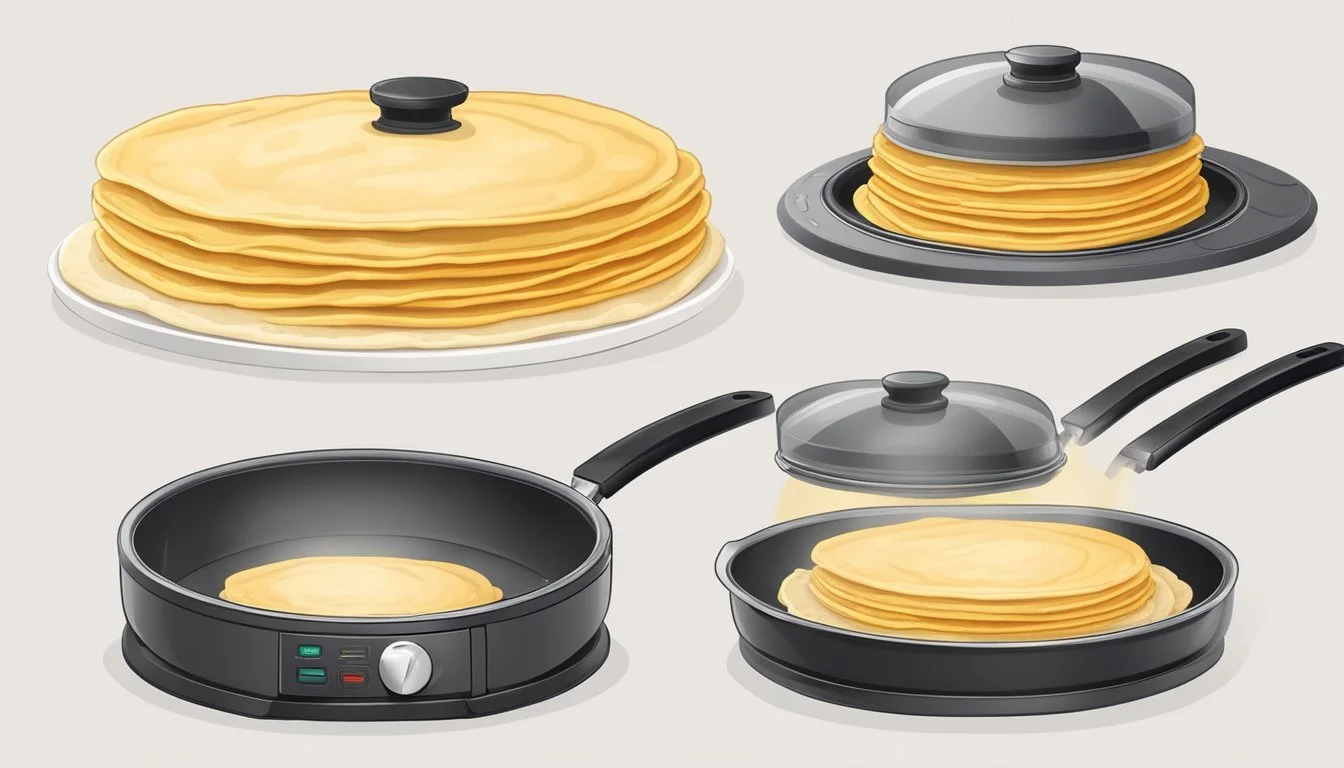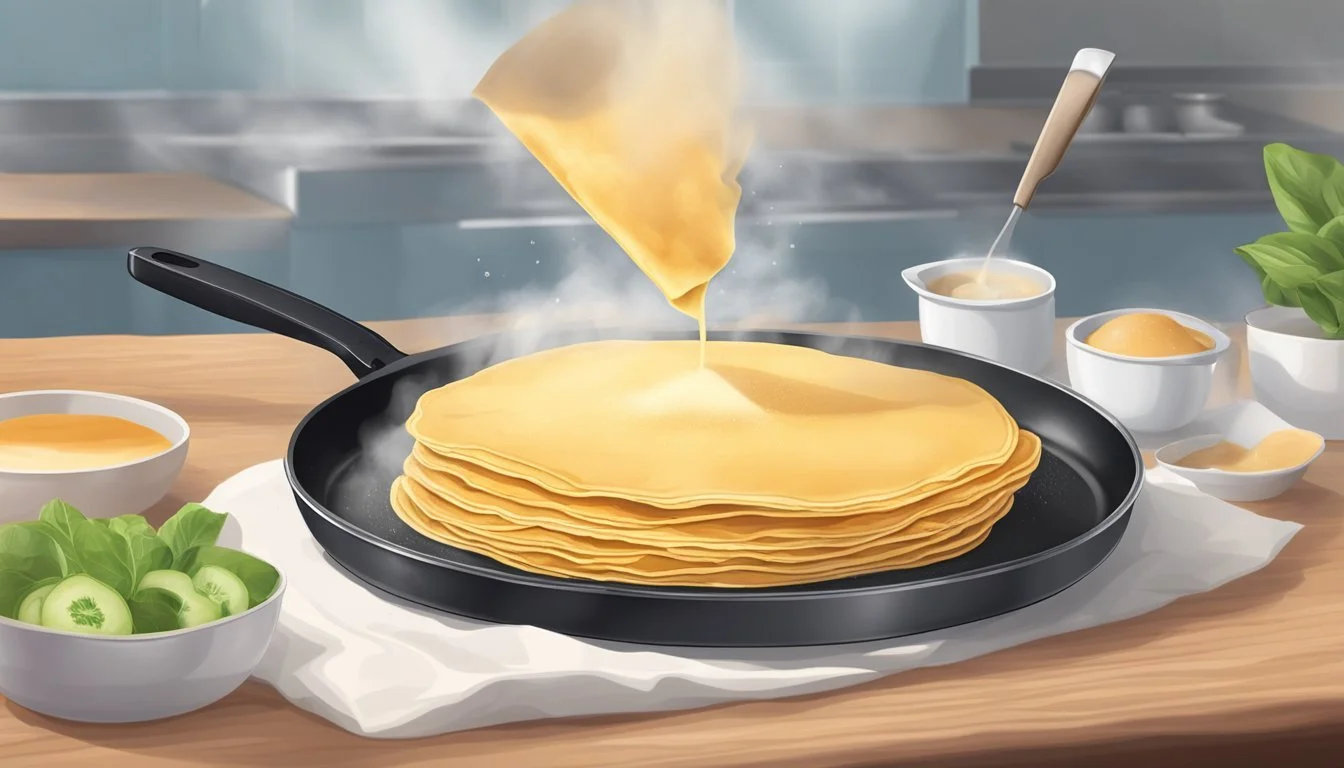Best Way to Reheat a French Crepe
Ensuring a Soft, Palatable Texture Every Time
Crepes, the delicate French pancakes known for their versatility, can be a delightful dish to enjoy even after their initial preparation. To maintain the fine texture and prevent them from turning rubbery, reheating crepes requires a gentle yet effective approach. The key is to apply enough heat to warm through without overcooking, which can lead to a compromise in their quality.
The best way to reheat crepes involves a few common kitchen tools and some simple techniques. One can use a non-stick skillet, an oven, or even an air fryer to achieve the desired warmth without drying out the crepes. Each method ensures the crepes retain their softness and pliability, making them nearly as good as when they were first made. Success lies in managing the heat and the process, whether using a skillet, oven, or air fryer, to prevent the delicate crepes from losing their texture and becoming rubbery.
Understanding Crepes
This section provides insights into the nature of crepes, their storage considerations, and essential preheating techniques to preserve their quality.
Crepes Overview
Crepes are thin, delicate pancakes that originated in France. The batter for crepes is typically made from flour, eggs, milk, and butter, resulting in a light texture and a subtle, inviting flavor. Crepes can be served in two main varieties: sweet crepes, filled with ingredients like fruits, chocolate, and cream; and savory crepes, which may contain cheese, meat, and vegetables. A crucial aspect of their appeal is the balance between a soft yet slightly crisp texture that can be compromised if not handled properly.
Storing Crepes
To maintain the quality of crepes, proper storage is key. Leftover crepes can be stored in the fridge for a few days or in the freezer for up to two months. For either method, crepes should be kept in an airtight container, separated by layers of wax or parchment paper to prevent sticking. If using plastic wrap or aluminum foil, ensure it is tightly sealed around the crepes. When stored correctly, this prevents moisture loss and flavor degradation. If frozen, crepes should be gradually thawed to room temperature before reheating to maintain their texture.
Preparing Crepes for Reheating
Before reheating crepes, they should be brought to room temperature to ensure even warming. Paper towels can be used to cover crepes when reheating in a microwave to keep them moist. This prevents the crepes from becoming rubbery or dry. When handling the crepes, one should be gentle to preserve the integrity and avoid tearing, especially as they become pliable when warm.
Reheating Methods Explained
When reheating a French crepe, maintaining its delicate texture and flavor is crucial. The key is to avoid high temperatures that can quickly turn the crepe rubbery, while preserving its moisture. Several methods can achieve this, each with their own merits.
Oven Reheating
To reheat crepes in an oven, preheat it to 350°F. Crepes should be wrapped in foil or placed on a baking sheet, and warmed for 10 minutes. This method distributes heat evenly, ensuring a gentle warming process that maintains the crepes' texture.
Stovetop Technique
Using a stove, heat a non-stick skillet or pan over medium heat. Lightly coat the pan with butter or cooking spray, then warm each side of the crepe for 30-60 seconds. This technique retains the crepe's moisture while presenting a slight crispness to the edges.
Microwave Method
For a quick microwave reheat, cover the crepes with a lightly damp paper towel to provide moisture, and microwave on medium power in 30-second intervals. This method prevents drying out but should be monitored closely to prevent the crepes from becoming too soft or losing their structure.
Utilizing Kitchen Appliances
Kitchen appliances like toaster ovens and air fryers offer additional reheating options. A toaster oven can be set to 350°F, and crepes are toasted until just warm, providing a crisp exterior. An air fryer at the same temperature with crepes wrapped in foil allows for a quick reheat—around 2-3 minutes—preserving the flavor and texture.
Alternative Reheating Approaches
Alternatively, crepes can be reheated on a non-stick pan over a stovetop without adding fats, or in a skillet for a buttery flavor and finish. Any added fillings should be considered, as some may require specific reheating methods to ensure the crepes and fillings are warmed uniformly.
Tips for Best Results
Reheating a French crepe requires attention to detail to maintain its delicate texture and flavor. The following tips are essential for achieving optimal results, whether the crepes are sweet or savory.
Avoiding Common Mistakes
Overcooking: A common pitfall is leaving crepes on heat too long, resulting in rubbery textures. To prevent this, one should reheat crepes just until they're warm to the touch.
High Heat: Using too high heat can quickly dry out the edges and make them crispy in an unintended way. Employing low to medium heat in a non-stick skillet or a similar gentle warming method is ideal.
Ensuring Optimal Texture
Moisture Balance: To keep crepes moist, they may be lightly covered with a paper towel when using methods such as microwaving.
Layering: When reheating multiple crepes, placing a layer of parchment paper between them can prevent sticking and help distribute warmth evenly, especially when using an oven or air fryer.
Preserving Flavor and Freshness
Toppings: Fresh toppings like fruit should be added after reheating to maintain their freshness.
Flavorful Warmth: It's best to avoid covering crepes with foil when reheating in an oven as it may trap too much moisture. Instead, loosely tent them to keep the flavor intact while allowing for gentle heating.
Serving and Presentation
When presenting a reheated French crepe, one's goals are to enhance flavor, maintain texture, and create visual appeal. The choice of fillings and final touches are pivotal in achieving a balance between taste and presentation.
Choosing Appropriate Fillings
For breakfast or brunch, fillings such as scrambled eggs, cheese, and ham fit perfectly, whereas dessert crepes can be filled with sweet options like Nutella, fresh berries, or cream cheese (how long does cream cheese last?). The crepe's versatility allows it to cater to a crowd with diverse tastes. Here's a guide for choosing fillings based on the occasion:
Breakfast/Brunch:
Savory: Cheese, mushrooms, diced ham
Sweet: Lemon juice and sugar, maple syrup, fresh fruit
Dessert:
Rich: Nutella, whipped cream, mascarpone
Light: Fresh berries, powdered sugar, fruit compotes
If one intends to store crepes for later use, it is best to leave them unfilled to prevent sogginess and choose fillings just before serving.
Adding Final Touches
The final touches are a declaration of the care put into the meal. A dollop of whipped cream can elevate a simple crepe to a sumptuous treat, while a sprinkle of powdered sugar adds a hint of sweetness and sophistication. For a zesty kick, a few drops of lemon juice can invigorate the palate, especially with sweet crepes. Top the crepe with fresh fruit for a fresh and visually appealing garnish, providing a contrast in both flavor and texture.
Remember, the presentation should not overshadow the crepe itself; it should complement the delicate warmth and texture of the reheated crepe. Here is a table highlighting the ideal final touches for each type of crepe:
Type of Crepe Final Touches Breakfast A light sprinkle of cheese, a sprig of fresh herbs Brunch A side of fresh fruit, a drizzle of syrup Dessert A dusting of powdered sugar, a handful of berries, a swirl of whipped cream
Each element should be placed carefully to create an appetizing ensemble that is as much a feast for the eyes as it is for the palate.
Troubleshooting
Ensuring that crepes maintain their texture and flavor when reheated can be challenging. This section addresses common issues and provides specific guidance on reheating crepes.
Frequently Asked Questions
Q: Why do my crepes get rubbery when I reheat them?
A: Reheating crepes at too high a temperature or for too long can overcook them, leading to a rubbery texture.
Q: Can I reheat filled crepes?
A: Yes, but it's important to reheat them gently to prevent the filling from causing soggy or unevenly heated crepes.
Q: Is it better to reheat crepes in the microwave or on the stovetop?
A: The stovetop method tends to preserve the texture better, but if using a microwave, do it in short bursts to avoid drying them out.
Solving Reheating Issues
Uneven Heating: Make sure crepes are heated evenly by flipping them halfway through the reheating process.
Rubbery Texture: To avoid a rubbery texture, reheat crepes on medium heat for a shorter duration and do not overstack them.
Drying Out: Lightly coat the pan or the crepes with butter if reheating on the stovetop or cover them with foil in the oven to retain moisture.
Adjusting Technique for Different Crepe Types
Sweet Crepes:
For sweet crepes, a quick warm-up on the stovetop is typically sufficient, as they often contain sugars that can burn easily.
Savory Crepes:
Savory crepes can benefit from reheating in an oven to maintain their crisp edges, especially when filled with cheese or meats.
When reheating any type of crepe, it's key to closely monitor the heat and timing to preserve the integrity of the crepe's flavor and texture.
Conclusion
Reheating French crepes to perfection centers around maintaining their delicate texture and avoiding rubberiness. The key is gentle heat application.
Skillet Method: She heats her crepes individually in a butter-coated non-stick skillet over medium heat—30 seconds each side suffices.
Oven Approach: She opts for the oven when working with multiple crepes. She preheats it to 350°F, wraps the crepes in foil, and heats them for about 10 minutes.
Toaster Oven Use: For a crispier exterior, the toaster oven is her go-to. She reheats the crepes until they're warm inside with a slightly crispy shell.
Air Fryer Option: In cases where crispness is desired, she sets the air fryer to 350°F. The crepes, separated by parchment and wrapped in foil, take about 2-3 minutes to heat.
Each method has its merits, with the oven and skillet providing the most control over the outcome. It is essential to monitor the crepes closely during reheating to prevent overcooking. Whether one is aiming for a soft and pliable texture or a slight crispness to the edges, a gentle approach ensures the crepes retain the qualities of freshly made fare. Serving the crepes immediately after reheating guarantees optimal enjoyment.
Additional Tips for Crepe Enthusiasts
When one enjoys crepes regularly, it's beneficial to understand the nuances of crepe storage, flavorful repurposing of leftovers, and appropriate serving occasions. This section offers specific guidance.
Freezing and Thawing Best Practices
Freezing Crepes: To maintain the delicate texture of crepes, they should be cooled to room temperature before freezing. Once cooled, layer each crepe between sheets of wax paper or parchment paper to prevent sticking. Then, one should place the stacked crepes in an airtight container or wrap them securely in plastic wrap and aluminum foil. This method helps in preserving their flavor and texture for up to two months.
Thawing Crepes: Proper thawing is crucial to avoid damaging the crepes. They should be transferred from the freezer to the refrigerator and allowed to thaw overnight. To ensure they don't become soggy, one must remove them from the airtight container and let them come to room temperature before reheating.
Creative Ways to Use Leftover Crepes
Crepes can transform from a delightful breakfast to an enticing dessert or even serve as a wrap for savory fillings. Leftover crepes can be filled with a variety of ingredients to rejuvenate their flavor. Here are a few ideas:
Breakfast: Spread nut butter and fresh fruit, then roll and slice into bite-sized pieces.
Brunch: Stuff with scrambled eggs, cheese, and spinach for a savory twist.
Dessert: For a sweet treat, fill with chocolate hazelnut spread and sliced bananas, then gently reheat.
Crepes for Every Occasion
Crepes are not only versatile in flavor but also suitable for various events.
Breakfast or Brunch: Serve them with a side of maple syrup or whipped cream and fresh berries for a light yet fulfilling start to the day.
Dessert Crepes: Enhance with sweet fillings such as fruit compotes or cream cheese fillings and present with a dusting of powdered sugar for an elegant dessert.
Catering to a Crowd: Reheating crepes in batches using the oven ensures they warm evenly, making them ideal for serving at gatherings.
Preparing crepes in advance and understanding the ways to keep their texture and taste intact helps crepe enthusiasts enjoy this delicate dish whenever the craving strikes.








